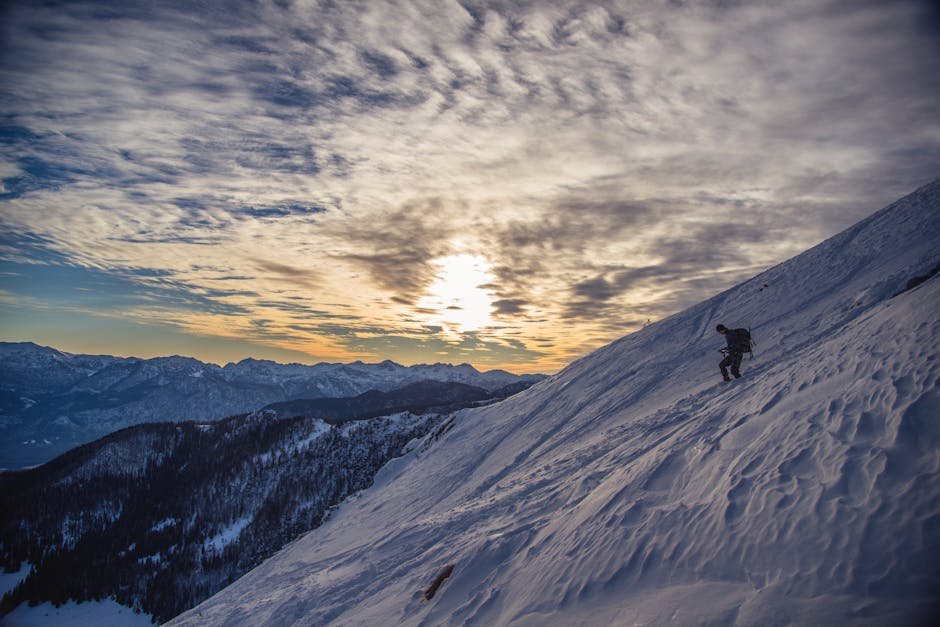Preparing for Your First Ice Climbing Adventure: A Beginner's Guide
Introduction to Ice Climbing Tours for Beginners
Ice climbing might sound intense, and truth be told, it is. But, that doesn’t mean it’s out of reach for beginners. With the right introduction through guided tours, anyone keen to learn can start their ice climbing journey. Think of it as mountain climbing's chilly cousin, where instead of rock faces, you conquer ice formations like frozen waterfalls and glaciers. These tours are tailored for those new to the sport, focusing on safety, technique, and, yes, fun. You'll learn the ropes, literally and figuratively, from how to use ice axes and crampons to mastering the art of climbing up icy verticals. Most importantly, beginners' tours ensure that you scale appropriate challenges under the watchful eyes of experienced guides. So while ice climbing may seem daunting at first, remember, every expert climber was once a beginner, just like you.
Essential Gear and Equipment for Ice Climbing
To start ice climbing, you need the right gear. This isn't a hobby you can just jump into. First, you need ice axes. These are your lifelines. They help you climb up the ice. You'll hold one in each hand. Next, crampons are a must. They attach to your boots and give you the grip you need on the ice. Then, a climbing harness. This keeps you attached to your rope for safety. Don't forget the helmet. Ice can fall, and you want your head protected. A belay device helps manage the rope. It's crucial for safety, making sure you don't fall too far. Rope is another essential. It should be strong and designed for ice climbing. Ice screws are used for protection. You screw them into the ice and attach the rope. They're your safety nets. Finally, wear warm, water-resistant clothing. You're going to be in cold, wet conditions. Dress in layers. Remember, this gear is an investment in your safety. Don't cut corners. Get the best you can afford.
Physical Fitness: Preparing Your Body for Ice Climbing
Ice climbing demands more than just courage; it requires solid physical fitness. First off, work on your endurance. Ice climbing isn't a sprint; it's more akin to a marathon with intervals. Start with activities like jogging, cycling, or swimming to build up your stamina. Next, you can't ignore upper body strength. You'll be using your arms a ton to pull yourself up. Incorporate exercises like pull-ups, push-ups, and rows into your routine. Meanwhile, don't forget your legs. Squats and lunges will prepare your legs to support your climbs and provide the necessary stability on ice. Lastly, ice climbing puts your core to the test. A strong core keeps you balanced and supports your body through each movement. Planks and other core exercises are crucial. Remember, in ice climbing, your body's fitness can make a huge difference. So, take time to prepare and ensure you’re physically ready for what's ahead.
Understanding the Basics of Ice Climbing Techniques
Ice climbing might seem daunting at first, but once you get the hang of the basics, you'll find it's an exhilarating way to explore the frozen outdoors. First things first, let's tackle the basic techniques you need to master. Kicking and swinging are your bread and butter in ice climbing. You need to kick your crampons into the ice to create a stable foothold and swing your ice axes to make anchors above you. Always aim to distribute your weight evenly and trust your gear. Another crucial technique is the rest step. This allows you to conserve energy during your climb. Essentially, you're leveraging your skeletal structure more than your muscles by locking your back leg and resting briefly in between movements. Then comes the body posture. Keep your hips close to the ice face; it provides balance and efficiency while minimizing effort. Remember, climbing is more about finesse than force. Use your axes and crampons just enough to hold you, not to exhaust you with deep, unnecessary swings or kicks. Practice these techniques on smaller, less steep ice formations before tackling bigger climbs. With persistence and patience, you'll improve and soon be ready for more challenging adventures.
Choosing the Right Ice Climbing Tour for Beginners
Picking the right ice climbing tour isn't hard, but it matters. If you're starting, look for tours labeled "beginner-friendly" or "introductory". These tours have guides that know how to handle new climbers and typically choose routes that are challenging enough to be exciting but not so tough they're discouraging. Key points to consider include the tour’s location, the guide-to-climber ratio, and the length of the tour. A lower ratio means more personal attention, which is crucial when you’re learning the ropes. Also, check reviews online or ask for recommendations. Finally, don’t shy away from asking the tour organizers questions about their safety measures, equipment provided, and what you need to bring. Remember, the goal is to learn in a safe environment and have fun while doing it.
Safety First: Key Ice Climbing Safety Tips
When it comes to ice climbing, putting safety first isn't just smart, it's essential. The thrill of ascending icy verticals comes with real risks, from falling ice to sudden weather changes. Here's how you can minimize those dangers and enjoy your climb. Always wear a helmet. Falling ice, even small pieces, can be lethal. A helmet protects your head, the command center for the rest of your body. Use a harness properly. It's your lifeline on the ice, connecting you to your rope and the ice itself through anchors. Double-check it before you start climbing. Know how to use your ice tools and crampons. These are your hands and feet on the ice. Make sure they're sharp and you're comfortable using them in different situations. Check the weather and ice conditions. Ice can change with the weather, becoming brittle or melting. Know what you're climbing into and be prepared to change plans if necessary. Climb with a partner. Ice climbing solo increases your risk significantly. A partner can help check your gear, call for help if needed, and vice versa. Take a course or go with a guide if it's your first time. Learning from experienced climbers improves your skills and safety awareness. Remember, the mountain will always be there another day. If conditions aren't right or you're not feeling up to it, it's okay to back out. These tips, while straightforward, form the foundation of staying safe while ice climbing. It's about making sure you can enjoy many more climbs to come.
What to Expect on Your First Ice Climbing Adventure
Ice climbing is nothing shy of an adrenaline-packed adventure, but it's not just about the thrill. For first-timers, it's crucial to know what's in store. Expect to start early, as most climbs begin in the quiet, crisp hours of the morning to take advantage of the ice's best conditions. Your muscles might scream in protest because climbing ice is physically demanding. You'll use muscles you didn't know existed, testing your physical stamina and mental grit.
The cold is another constant companion. Dressing in layers is not just advisable; it's essential. You’ll oscillate between feeling too warm as you climb and too cold when you rest. And then there's the ice itself. It can be unpredictable, varying from solid, reliable sheets to fragile, brittle sections. Learning to read the ice is a skill you'll begin to develop on your first adventure.
Your guide will likely go over the basics of using ice axes and crampons, fundamental tools for your climb. Trust in these tools, and in your guide, is paramount. Safety always comes first, so you’ll also get acquainted with harnesses, helmets, and possibly ropes depending on the climb’s difficulty.
Lastly, expect to be humbled. Ice climbing is challenging and may not come easily at first. But with patience, persistence, and a positive attitude, conquering an ice wall offers an unparalleled sense of accomplishment. The views from atop an ice formation are breathtaking, making all the effort worth it. Remember, every expert ice climber started as a beginner. Your first ice climbing adventure is the first step on an exciting journey.
Navigating Ice Climbing Challenges as a Beginner
Ice climbing is an adrenaline-packed adventure but not without its hurdles, especially for beginners. First off, ice climbing demands both physical and mental strength. You'll be faced with sheer ice walls that require not just physical power to scale but the mental grit to overcome heights and the unpredictable nature of ice.
The cold weather is another challenge you need to be ready for. Unlike regular climbing, ice climbing exposes you to harsher, colder conditions. You'll need to dress appropriately in layers and have the right gear to keep warm without sacrificing mobility.
Then, there's learning to trust your equipment. For beginners, placing faith in ice axes and crampons to hold your weight on a vertical ice surface can be daunting. It's crucial to familiarize yourself with how these tools function and practice using them in a controlled environment before heading out.
Understanding ice conditions is a skill developed over time. Ice can be unpredictable; it can be solid in one spot and brittle in another. Beginners must learn to read the ice, recognizing safe from unsafe areas to dig their tools into.
Lastly, navigation can be challenging. Ice climbing locations are often in remote areas, making it easy to get lost. It's vital to go with an experienced guide who knows the area or ensure you have reliable navigation tools and skills.
Despite these challenges, overcoming them is part of the thrill and fulfillment of ice climbing. With proper preparation, training, and respect for nature's unpredictability, beginners can successfully navigate the world of ice climbing and enjoy the unique adventures it offers.
How to Enhance Your Ice Climbing Skills Post-Tour
Once you've had a taste of the icy vertical world, improving your climbing skills becomes essential. First off, focus on building your core strength; it's the key to better balance and endurance on ice. Incorporate exercises like planks and push-ups into your daily routine. Next, work on your grip. Hanging from a pull-up bar a few times a week can significantly improve your hand strength, vital for gripping your ice tools. Don't forget to practice using your ice tools off the mountain. A plywood setup in your garage where you can swing and plant your tools helps mimic ice climbing movements. Flexibility is also crucial. Regular stretching improves your range of motion, allowing you to reach further with your ice axe. Finally, get back on the ice as much as possible. Skills sharpen with practice. Consider joining a local climbing club or enlisting a mentor. They can provide valuable insights and push your limits safely. Remember, progress takes time. Be patient and keep challenging yourself.
Reflecting on Your First Ice Climbing Experience: A Summary
Reflecting on your first ice climbing experience, it could be nothing short of exhilarating, right? That moment when you looked up at the towering ice wall in front of you, you may have felt a mix of excitement and nerves. And that’s perfectly normal. Ice climbing demands not just physical strength but mental toughness too. You learned to trust your equipment – the ice axes in your hands and the crampons strapped to your boots. Remember the sound of your crampons crunching into the ice and how it felt to hoist yourself up, step by step? That was you conquering the ice, one swing, and kick at a time. Perhaps there were moments of doubt, where you questioned your ability or the safety of the climb. Yet, with guidance from more experienced climbers and trust in your own abilities, you overcame those fears. This adventure likely taught you about resilience, pushing beyond your comfort zone, and the importance of preparation. Looking back, you understand that every fall was a lesson and every summit a triumph. Ice climbing is more than just scaling icy heights; it’s about exploring your limits and discovering what you’re truly capable of. Whether you found a new passion or decided once was enough, your first ice climbing experience is a remarkable journey you'll look back on with pride.


